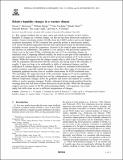Relative humidity changes in a warmer climate
Author(s)
Sherwood, Steven C.; Ingram, William; Tsushima, Yoko; Satoh, Masaki; Roberts, Malcolm; Vidale, Pier Luigi; O'Gorman, Paul; ... Show more Show less
Downloadsherwood_relative_humidity_2010.pdf (613.6Kb)
PUBLISHER_POLICY
Publisher Policy
Article is made available in accordance with the publisher's policy and may be subject to US copyright law. Please refer to the publisher's site for terms of use.
Terms of use
Metadata
Show full item recordAbstract
Key climate feedback due to water vapor and clouds rest largely on how relative
humidity R changes in a warmer climate, yet this has not been extensively analyzed in
models. General circulation models (GCMs) from the CMIP3 archive and several higherresolution
atmospheric GCMs examined here generally predict a characteristic pattern
of R trend with global temperature that has been reported previously in individual models,
including increase around the tropopause, decrease in the tropical upper troposphere,
and decrease in midlatitudes. This pattern is very similar to that previously reported for
cloud cover in the same GCMs, confirming the role of R in controlling changes in
simulated cloud. Comparing different models, the trend in each part of the troposphere is
approximately proportional to the upward and/or poleward gradient of R in the present
climate. While this suggests that the changes simply reflect a shift of the R pattern upward
with the tropopause and poleward with the zonal jets, the drying trend in the subtropics is
roughly 3 times too large to be attributable to shifts of subtropical features, and the
subtropical R minima deepen in most models. R trends are correlated with horizontal
model resolution, especially outside the tropics, where they show signs of convergence and
latitudinal gradients become close to available observations for GCM resolutions near
T85 and higher. We argue that much of the systematic change in R can be explained by
the local specific humidity having been set (by condensation) in remote regions with
different temperature changes, hence the gradients and trends each depend on a model’s
ability to resolve moisture transport. Finally, subtropical drying trends predicted from the
warming alone fall well short of those observed in recent decades. While this discrepancy
supports previous reports of GCMs underestimating Hadley cell expansion, our results
imply that shifts alone are not a sufficient interpretation of changes.
Date issued
2010-05Department
Massachusetts Institute of Technology. Department of Earth, Atmospheric, and Planetary SciencesJournal
Journal of Geophysical Research
Publisher
American Geophysical Union
Citation
Sherwood, S. C., W. Ingram, Y. Tsushima, M. Satoh, M. Roberts, P. L. Vidale, and P. A. O'Gorman (2010), Relative humidity changes in a warmer climate, J. Geophys. Res., 115, D09104, doi:10.1029/2009JD012585 ©2010 American Geophysical Union
Version: Final published version
ISSN
0148–0227